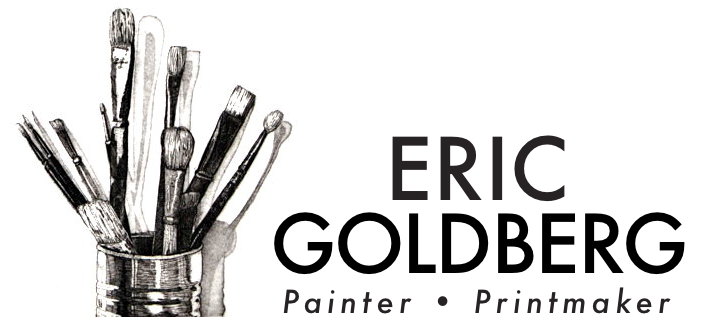Morning Light, 16x20"
Multi-plate etching and aquatint
The Print Club of Albany
150 Barrett St., Schenectady, NY 12305
www.pcaprint.com
Contact the Print Club of Albany
Eric Goldberg recently completed and delivered a commissioned edition of 100 prints titled "Morning Light". The prints were 16x20" multi-copper plate etching/aquatint.
Eric explains the printmaking process:
Bountiful • 18 x 12"• etching/aquatint
The Awakening
Into the Light • 18 x 16" • etching/aquatint
Studio Still Life • 9 x 5" • etching/aquatint
Still Life with Red Chair • etching/aquatint
Prints
Prints are made by transferring ink from a printing plate to a sheet of paper or other material. Multiple impressions from the same plate form an edition. Since the late 19th century, artists have generally signed individual impressions from an edition and usually number the impressions to form a limited edition; the printing plate is then destroyed so that no more prints can be produced.
Deep in the Valley • 7.75 x 21" • etching/aquatint
Morning Light
In Memoriam • 7.5 x 18" • etching/aquatint
Martha's View
Near the Uffizi (Will Draw for Food) • etching/aquatint
Midtown Midday • 6 x 22" • etching/aquatint
Printmaking
Printmaking is the process of making artworks by printing, normally on paper. The process is capable of producing multiples of a same piece, each of which is called a print. Each print produced is not considered a "copy" but rather is considered an "original". This is because typically each print slightly varies due the nature of the printmaking process, and also because the imagery of a print is not simply a reproduction of another work but rather a unique image designed from the start to be expressed in a particular printmaking technique. Printmaking is not only chosen for its ability to produce multiple impressions, but rather for the unique qualities of the printmaking processes itself.
Intaglio
Intaglio is the family of printing and printmaking techniques in which the image is incised into the surface of the plate, and the incised line or sunken area holds the ink. In intaglio printing, the lines to be printed are cut into a (copper) plate by using either a tool (engraving or dry point) or by using the corrosive action of an acid (etching). In etching the plate is covered in a resin ground or an acid-resistant wax material. Using an etching needle, the image is drawn into the ground, revealing the plate underneath. The plate is then dipped into acid. The acid bites into the surface of the plate where it was exposed. Biting is a printmaking term to describe the acid's etching, or incising, of the image. After the plate is sufficiently bitten, it is removed from the acid bath, and the ground is removed to prepare for printing.
Etching
Etching is an intaglio technique in which the surface of the copper plate remains blank while the lines, dots and patterns cut into the plate hold ink. In pure etching, a metal (usually copper, zinc or steel) plate is covered with a waxy or acrylic ground. The artist then draws through the ground with a pointed etching needle. The exposed metal lines are then etched by dipping the plate in a bath of etchant (ferric chloride or hydrochloric acid). The etchant "bites" into the exposed metal, leaving behind lines in the plate. The remaining ground is then cleaned off the plate, and the plate can be printed.
Aquatint
Aquatint is an Intaglio technique that involves the application of acid to make marks in a metal plate. Where the etching technique uses a needle to make lines that retain ink, aquatint relies on powdered rosin or thousands of dots of sprayed paint that is acid resistant to create a tonal effect across an area of the plate. The Aquatint can be burnished or incised to affect its tonal qualities. Another way to control the tones is by the amount of time the plate is in the acid bath.
Printing
Printing an intaglio plate is done by forcing the ink into the recessed lines, or grooves. The surface of the plate is then wiped with a cloth to remove most of the excess ink. The final smooth wipe is often done with newspaper or old public phone book pages, leaving ink only in the incisions. A damp piece of paper is placed on top of the plate; as the plate/paper go through the press the dampened paper will be squeezed into the plate’s ink-filled groves. The paper and plate are then covered by a thick blanket to ensure even pressure when going through the rolling press. The rolling press applies very high pressure through the blanket to push the paper into the grooves on the plate. The blanket is then lifted, revealing the printed image on the surface of the paper that was in contact with the inked plate.



